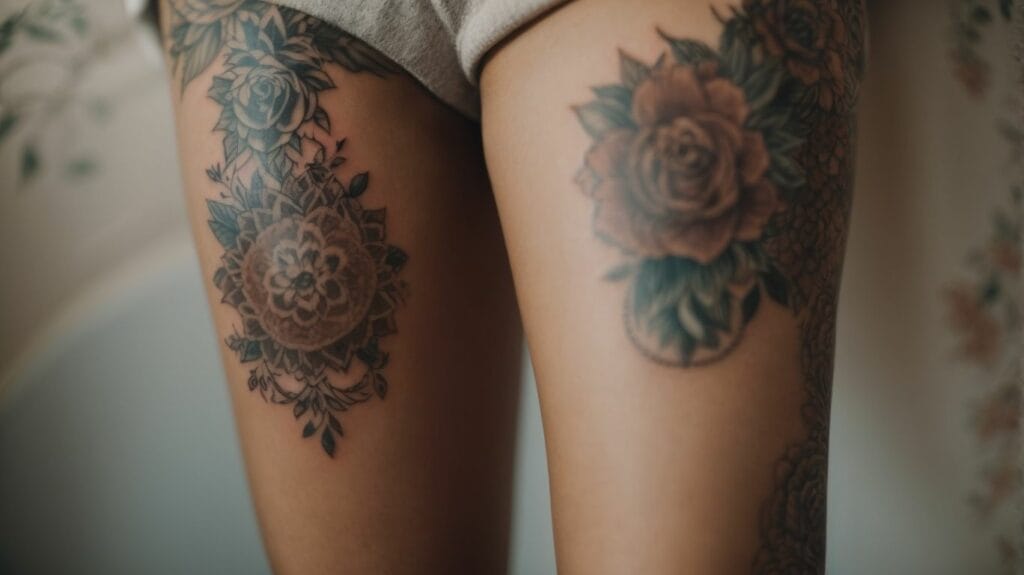Thigh tattoos have become increasingly popular among individuals looking to express their creativity and personal style. However, one common concern that often arises is, “Do thigh tattoos hurt?” The level of pain experienced during a tattooing session can vary depending on several factors. Understanding these factors can help individuals make an informed decision before getting a thigh tattoo.
Factors That Affect Tattoo Pain
- Location: The location of the tattoo plays a significant role in the level of pain experienced. Different areas of the body have varying levels of sensitivity, with some being more sensitive than others.
- Skin Sensitivity: Each individual’s skin sensitivity is unique. Some people have more sensitive skin, making them more prone to experiencing higher levels of discomfort during the tattooing process.
Thigh Tattoos: Do They Hurt?
When it comes to thigh tattoos, the pain level can vary from person to person. Several factors contribute to the level of discomfort experienced during a thigh tattoo session.
- Pain Level on the Thigh: The pain experienced during a thigh tattoo can range from mild to moderate. The outer thigh tends to be less painful compared to the inner thigh, which is more sensitive due to the proximity to nerves and bone.
- Comparison to Other Body Parts: In general, the thigh is considered to be a relatively less painful area to get tattooed compared to more sensitive areas such as the ribs or feet.
Techniques to Minimize Pain
While tattoo pain is subjective and cannot be eliminated, some techniques can help minimize discomfort during the tattooing process.
- Numbing Creams: Topical numbing creams can be applied to the skin before the tattooing session to help reduce pain and discomfort.
- Deep Breathing and Mind Distractions: Engaging in deep breathing exercises and focusing on distractions such as listening to music or engaging in conversation can help take the focus away from the pain.
Aftercare for Thigh Tattoos
Proper aftercare is crucial for the healing process of any tattoo, including thigh tattoos.
- Cleaning and Moisturizing: Keeping the tattooed area clean and moisturized helps promote healing and prevents infections. Following the tattoo artist’s aftercare instructions is essential.
- Avoiding Irritants: It is important to avoid exposing the tattooed area to irritants such as excessive sunlight, tight clothing, or abrasive materials that can hinder the healing process and cause discomfort.
By understanding the factors that affect tattoo pain, individuals can make an informed decision about getting a thigh tattoo and take appropriate measures to minimize any discomfort during the process. Proper aftercare is crucial for ensuring the tattoo heals properly and maintains its vibrant appearance over time.
Key takeaways:
- Location matters: The pain level experienced during a thigh tattoo can vary depending on the specific location chosen, with areas closer to bones or more sensitive skin generally causing more discomfort.
- Thigh tattoos can be less painful: Compared to other body parts, such as ribs or feet, the thigh generally tends to be less sensitive, resulting in potentially less pain during the tattooing process.
- Pain management techniques: Using numbing creams or employing deep breathing and mind distractions can help minimize pain during a thigh tattoo, making the experience more comfortable for individuals.
Factors That Affect Tattoo Pain
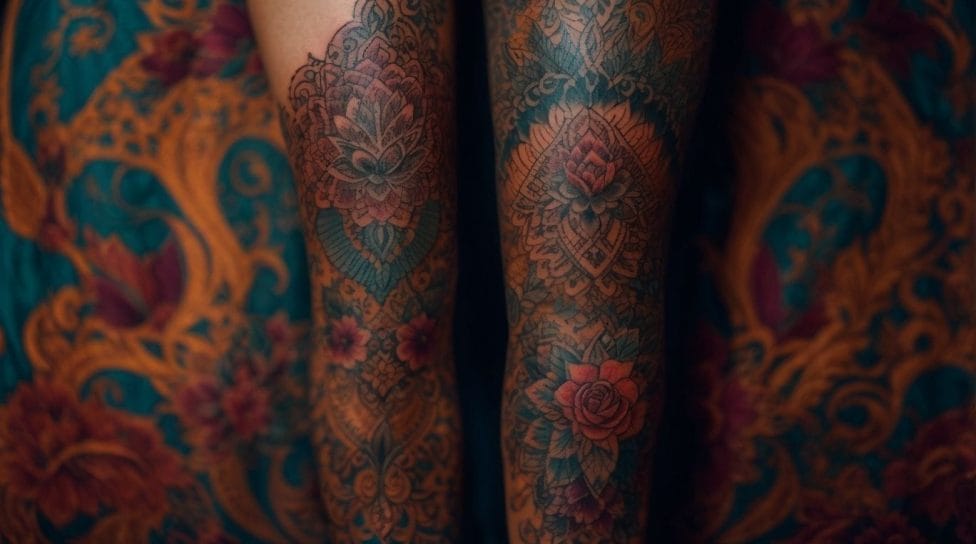
Photo Credits: Tattooineplanet.Com by Gregory Anderson
Curious about the pain levels of thigh tattoos? Let’s dive into the factors that influence tattoo pain, specifically focusing on the location and skin sensitivity. Discover how the placement of your tattoo on the thigh and the unique sensitivity of your skin can impact the overall pain experience. Brace yourself for some interesting insights that might ease your worries or make you think twice about that thigh masterpiece!
Location
When it comes to getting a tattoo, the location has a significant impact on the level of pain that one experiences. Different areas of the body have varying levels of sensitivity, such as the ribs or inner wrist, which tend to be more sensitive and, therefore, more painful. On the other hand, areas like the upper arm or thigh may be less sensitive, resulting in less pain. It’s crucial to take your pain tolerance into account and choose a location that aligns with it. Furthermore, factors like the thickness of the skin and the presence of nerve endings can also influence the pain level in a specific area.
Skin Sensitivity
When considering getting a tattoo, it is crucial to take skin sensitivity into account. Skin sensitivity varies among individuals, with some having more sensitive skin, thus experiencing more pain during the tattooing process. The location of the tattoo also matters, as certain areas of the body, such as the ribcage or inner arm, tend to be more sensitive compared to others, like the upper thigh or outer bicep. To minimize discomfort, it is recommended to prepare your skin by moisturizing regularly and ensuring it is in good condition. Additionally, it is essential to communicate your sensitivity level with the tattoo artist so that they can make adjustments accordingly.
Thigh Tattoos: Do They Hurt?
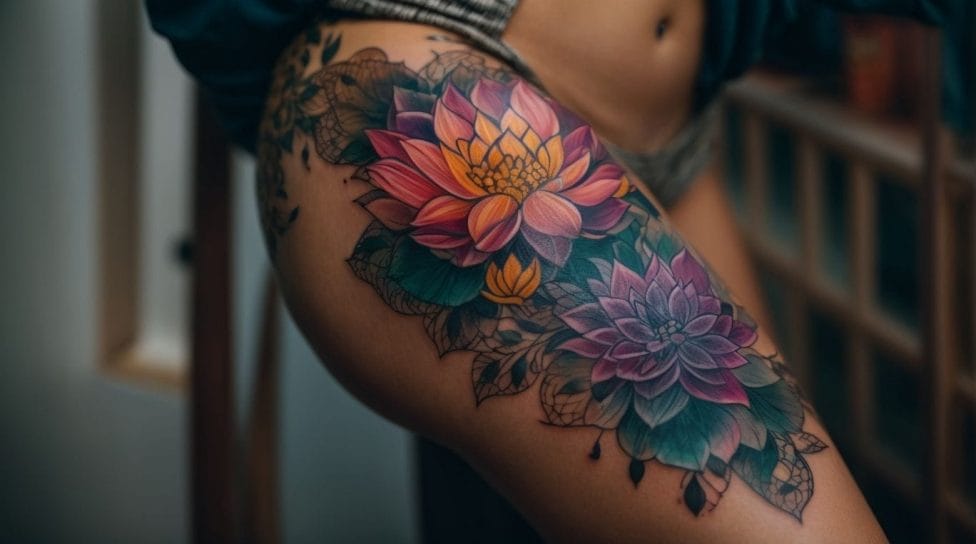
Photo Credits: Tattooineplanet.Com by Christopher Adams
Thigh tattoos: the burning question everyone wants answered – do they hurt? In this section, we dive straight into the pain aspect of thigh tattoos, exploring the pain level experienced on the thigh compared to other body parts. Brace yourself for some eye-opening insights and comparisons that will have you reevaluating your tattoo placement decisions. Get ready to uncover the truth behind the pain tolerance required for thigh tattoos. Let’s get real about the discomfort factor!
Pain Level on the Thigh
The pain level on the thigh during a tattoo can vary depending on several factors. It is important to consider these factors to understand what to expect.
| 1. Tattoo Placement | – Thigh tattoos generally have medium to high pain levels. The outer thigh is usually less painful than the inner thigh. |
| 2. Individual Sensitivity | – People have different pain thresholds, so the pain experienced during a thigh tattoo can vary greatly. |
To minimize pain during a thigh tattoo, you can consider using numbing creams and employing techniques like deep breathing and mind distractions. Aftercare, such as cleaning and moisturizing the tattoo and avoiding irritants, will help in the healing process.
True story: My friend recently got a tattoo on her thigh, and she described the pain level on the thigh as moderate. She used deep breathing techniques and found them helpful in managing the discomfort. After the tattoo, she followed the aftercare instructions and had a smooth healing process with minimal complications.
Comparison to Other Body Parts
When it comes to tattoo pain, the level of discomfort can vary depending on the location and your skin sensitivity. Comparing the pain level on the thigh to other body parts, there exists a notable differentiation in terms of discomfort. It is generally deemed that the thigh is a relatively less painful area for tattoos, primarily due to the greater thickness of the skin and lower concentration of nerve endings. For instance, getting a tattoo on the ribcage or inner wrist tends to provoke more intense pain. Techniques such as utilizing numbing creams and practicing deep breathing can be employed to mitigate the pain experienced during the tattooing process effectively. Additionally, proper cleaning, moisturizing, and avoidance of irritants are crucial aspects of aftercare for thigh tattoos.
In a historical context, tattooing has been practiced for thousands of years across different cultures. The pain endured throughout the process has served as an intrinsic component of the tattooing tradition, representing endurance and unwavering dedication to the design. Nevertheless, advancements in technology and techniques have significantly enhanced the accessibility of tattoos and alleviated the associated discomfort. The comparison of pain among various body parts continues to be an essential consideration for individuals contemplating getting a tattoo.
Techniques to Minimize Pain
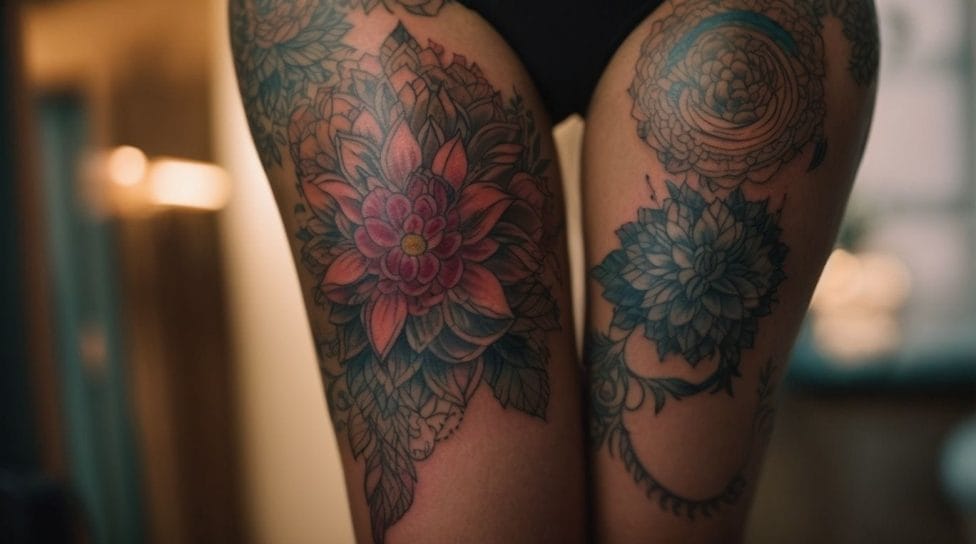
Photo Credits: Tattooineplanet.Com by Donald Roberts
Discover effective techniques to minimize the pain of thigh tattoos. From numbing creams to deep breathing and mind distractions, these methods can help alleviate discomfort during the tattooing process. Say goodbye to unnecessary pain and explore ways to enhance your tattoo experience. Soothe your skin, calm your mind, and ensure a more enjoyable and tolerable thigh tattoo session.
Numbing Creams
Numbing creams, such as lidocaine or benzocaine-based products, are a popular choice among tattoo enthusiasts who want to minimize pain during tattoo sessions. These creams work by numbing the skin’s surface, which in turn makes the entire tattooing process more comfortable. To ensure maximum effectiveness, it is recommended to apply the numbing cream around 30-60 minutes prior to the scheduled tattoo session. Each numbing cream comes with specific application instructions, so it is crucial to follow the provided guidelines carefully.
It is also important to discuss with the tattoo artist beforehand. This conversation will help address any specific preferences or concerns they may have regarding the use of numbing creams. By coordinating with the tattoo artist, you can ensure that the numbing cream is seamlessly integrated into the tattooing process.
For more information on whether thigh tattoos hurt, you can visit the Do Thigh Tattoos Hurt? Page.
In ancient times, natural numbing agents like coca leaves were used by various cultures to alleviate the pain associated with tattoos. However, in today’s modern society, numbing creams have become a more convenient and effective solution for those who want a more comfortable tattoo experience. With their numbing properties, these creams offer a way to enjoy the art of tattooing without excessive discomfort.
Deep Breathing and Mind Distractions
- Deep Breathing and Mind Distractions: Incorporate deep breathing and mind distractions to minimize pain during a tattoo session on the thigh. Follow these steps:
- Take deep breaths: Inhale slowly through your nose, hold for a few seconds and exhale through your mouth. This deep breathing technique helps relax your body and divert your focus from the tattoo pain.
- Visualization: Use the power of your mind to imagine yourself in a soothing environment or engaged in a distracting activity. This visualization technique helps redirect your thoughts away from the discomfort of the tattooing process.
- Engage in conversation: To keep your mind occupied and provide a welcome distraction, have a conversation with the tattoo artist or bring a friend along to chat with.
- Listen to music or podcasts: Bring headphones and listen to your favorite music or podcasts during the tattoo session. This will help take your mind off the pain and provide a pleasant diversion.
Deep breathing and mind distractions have been utilized as effective pain management techniques for centuries. In fact, ancient Greek and Indian cultures have long embraced these methods. By tapping into the power of your mind, you can effectively divert attention from the discomfort and promote a sense of calm during physically challenging experiences like tattooing.
Aftercare for Thigh Tattoos
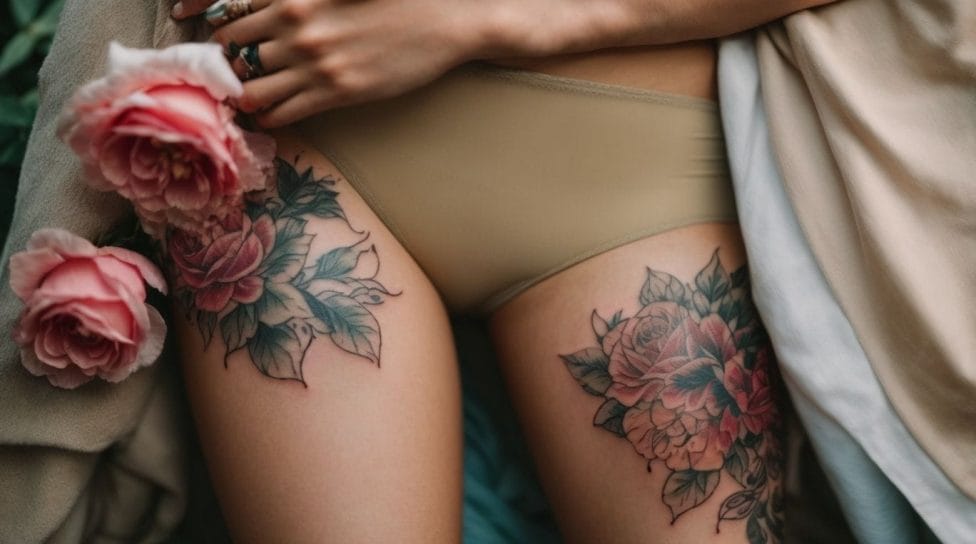
Photo Credits: Tattooineplanet.Com by Larry Lee
Discover how to properly care for your thigh tattoos and ensure a smooth healing process. From cleaning and moisturizing to avoiding irritants, we’ll explore the essential aftercare steps you need to know. Say goodbye to potential infections or fading colors as we dive into the best practices for maintaining the vibrancy and longevity of your thigh tattoos. Keep those beautiful ink creations looking their best with our comprehensive aftercare tips.
Cleaning and Moisturizing
To properly clean and moisturize your thigh tattoo, follow these steps and incorporate the keywords naturally:
- Gently cleanse the tattoo using mild, fragrance-free soap and lukewarm water to ensure effective cleaning and moisturizing.
- Pat the tattoo dry with a clean, soft towel or allow it to air dry, promoting proper moisture retention.
- Apply a thin layer of fragrance-free, non-comedogenic moisturizer to keep the tattoo hydrated, aiding in cleaning and moisturizing.
- Avoid picking or scratching the tattoo to prevent infection or damage to the healing process, thus ensuring successful cleaning and moisturizing.
- Safeguard the tattoo from direct sunlight and excessive friction by wearing loose clothing and applying sunscreen when necessary, contributing to its cleaning and moisturizing efforts.
After acquiring a thigh tattoo, Sarah diligently followed the prescribed cleaning and moisturizing routine. As a result of her commitment to proper aftercare, her tattoo healed beautifully and maintained its vibrant colors. Sarah takes great pride in displaying her thigh tattoo, understanding that it not only reflects her style but also embodies her dedication to the consistent maintenance of cleanliness and hydration.
Avoiding Irritants
To prevent irritation, it is crucial to care for your thigh tattoo during its healing process adequately.
- Cleansing: Gently cleanse the tattoo with a mild, fragrance-free soap and warm water. Refrain from harsh cleansers or scrubbing, as they may irritate the skin.
- Moisturizing: Apply a thin layer of fragrance-free, non-comedogenic moisturizer to keep the tattooed area well-hydrated. Avoid using lotions with added fragrance or petroleum-based products, as they can lead to irritation.
- Avoiding irritants: Throughout the healing process, steer clear of activities that may irritate the tattooed area, such as excessive sweating, direct sunlight exposure, swimming in chlorinated water, or wearing overly tight clothing that rubs against the tattoo.
Facts:
Some Facts About Do Thigh Tattoos Hurt?
- ✅ Thigh tattoos can be sensitive and may cause varying levels of pain. (Source: Hush Anesthetic)
- ✅ The inner thigh is one of the most sensitive areas to get a tattoo. (Source: Hush Anesthetic)
- ✅ The back of the thigh is slightly less sensitive than the inner thigh but can still be sensitive, especially near the back of the knee. (Source: Hush Anesthetic)
- ✅ The front of the thigh is less sensitive than the inner and back thigh areas. (Source: Hush Anesthetic)
- ✅ The outer thigh is the least sensitive area of the thigh. (Source: Hush Anesthetic)
